Circular Design SPRINT
In this post I tell you the experience of participating in a Design SPRINT, and how Ecoembes used the Design SPRINT methodology to explore new ideas in the context of circular economy and recycling.
In order to do that, they recruited through scholarships an eclectic group of professionals, including entrepreneurs, marketing, design and technology professionals, among which I am included. During 5 days in July 2018, we worked together in The Circular Lab, an innovation space of Ecoembes located in Logroño, particularly prepared for creative and collaborative work.
The scholarship consisted of a course on Design SPRINT methodology, during which we made a real SPRINT for Ecoembes. Taught by UXER School, we applied Design SPRINT to the world of recycling, and in just 5 days we were able to propose and develop innovative ideas that solve problems in a business that we did not know initially.
Executive Summary
This will be a long article, for which I have decided to create a summary so that the reader can understand the global idea, and then decide if he wants to go into all the details.
Design SPRINT -or just SPRINT- is a surprisingly productive methodology, which allows to obtain excellent results in a short period of time.
It can be applied to the development of a product or service at the beginning of a project, but also to the development of a functionality of an already existing product or service, or to the improvement of any process. It is a flexible methodology that has been applied successfully in many areas.
Individual production and collective decision making are encouraged. This promotes, on the one hand, the generation of more open ideas. When thinking and producing we will do that individually, so that we do not receive negative feedback that restrains us or limits us. On the other hand, decision making is collective, using a flat hierarchy, which makes us support and engage even with ideas that we did not generate ourselves, but with which we agree.
In my opinion, the success of the process is determined by several factors. In the first place, it is important to form a multidisciplinary team, which will provide us with different points of view in the generation of ideas. Another important aspect of the methodology is the short deadlines: most tasks have a very limited term of 5, 10 or 15 minutes, which makes us work under pressure, forcing us to quickly choose and discard ideas.
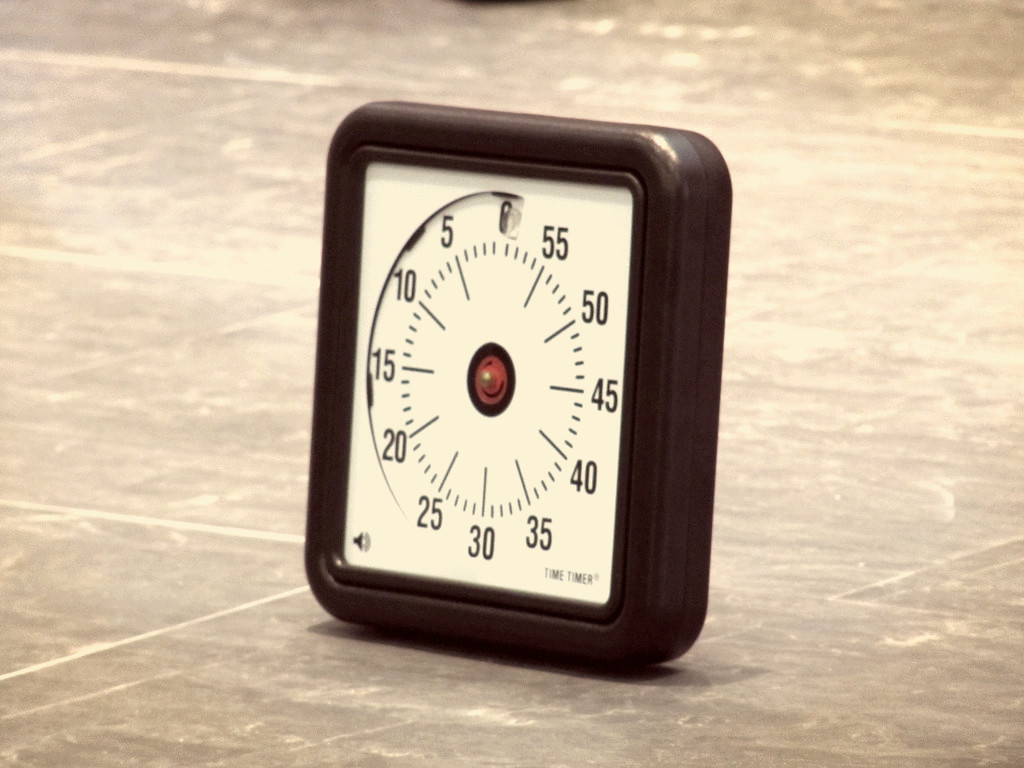
Another important aspect is to leave the egos aside, to do without the superheroes -focus on the collective work instead of giving all the prominence to the gurus or experts- and be able to give up to your own ideas -when the team decides that an idea is not going to be used, we must not press to include it again.
To lead the process, set the guidelines, foster to prevail the collective spirit and unravel the blockages there is the figure of the facilitator. In this case the facilitator was Javier Larrea from UXER SCHOOL.
Seen in retrospect, the process feels like an initially messy puzzle, in which little by little pieces are fitting together, almost automatically.
Finally, it should be clarified that Design SPRINT is a methodology adaptable to each project and organization, therefore some processes may differ from what we find in the official book or what we found in other SPRINTs.
Design SPRINT in a nutshell
Design SPRINT is a methodology that typically takes place over 5 days.
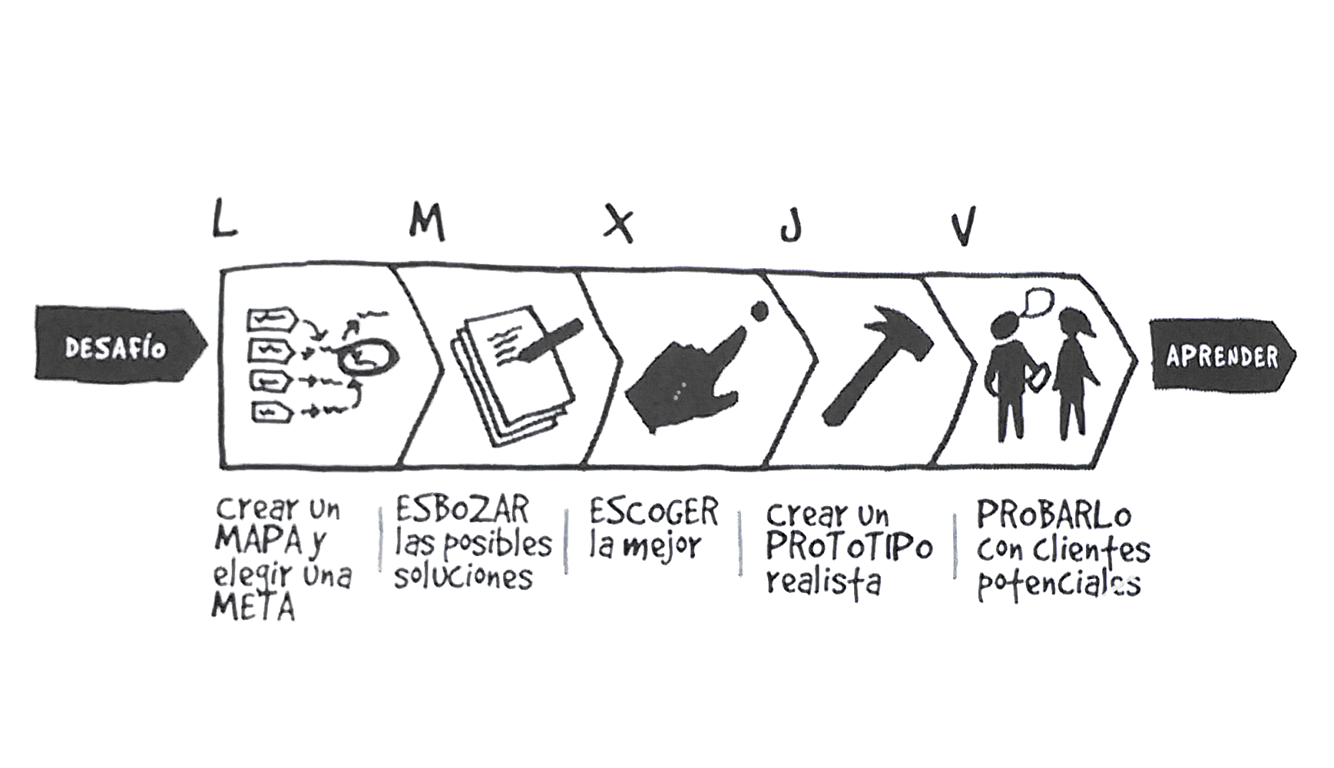
Day 1. Map
We define the problem, articulating assumptions, identifying the consumer and achieving that all stakeholders are aligned on the same objective and with the same information.
Day 2. Sketch
We explore multiple ways of solving the problem, regardless of whether it is viable or not. This freedom to explore and be creative can often give us very novel concepts and ideas.
Day 3. Decide
By not having time to prototype all ideas, it is necessary to have a process to decide which is the best idea and which ones we should abandon. Sometimes a single version will be chosen, while others we will decide to validate a few alternatives.
Day 4. Prototype
We want to build a prototype of medium fidelity, pretty much a facade, but we do not have content, or information architecture, or wireframes... We must work together to achieve a believable prototype that allows us gather quality information from testing.
Day 5. Test
Finally the day came! The aim here is to validate (or not to validate) the product ideas with real users, discover errors in the concept design, understand the users and, ultimately, create a product that people want to use.
Day 1. Map
Creation of teams
The participants were divided into 3 groups, previously formed by the organizers. Each group was made up of a mix of profiles -designers, marketers, entrepreneurs, engineers-, also belonging to different age groups.
Each participant made a brief presentation of who he is, what he is doing and why he signed up for the Circular Design SPRINT.
Challenge
The client presented us with the challenge, that is, a result that the client wants to obtain. This should be the focus of the solutions that we will create in the SPRINT.
Ecoembes Challenge: How can we encourage and motivate citizens to better recycle domestic packaging?
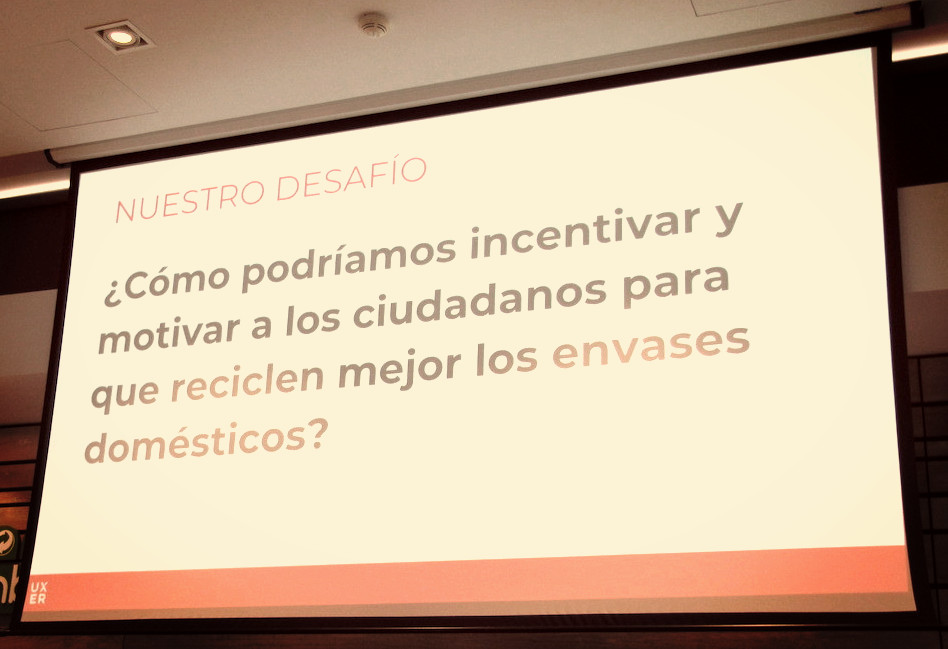
The challenge could be focused on both citizens as well as the HORECA channel (HOtels, REstaurants and CAtering).
Then several activities were carried out in order to approach the context of the challenge: the world of recycling.
Interviews
In pairs, we carried out two interviews among the participants, trying to find out what their consumption habits were, as well as their environmental awareness and recycling patterns.
Presentation of the client
Introduction to the origin, work and objectives of Ecoembes, by Zacarías Torbado.
Stakeholders map
In a graph with 3 concentric circles we had to place the stakeholders related to the recycling process, in the following way:
- In the inner circle we had to put the internal stakeholders, that is, the direct users: citizens or restaurants in the case of HORECA.
- In the intermediate circle went the direct stakeholders, those who deal directly with the user.
- In the outer circle went the indirect ones, those who do not deal directly with the user.
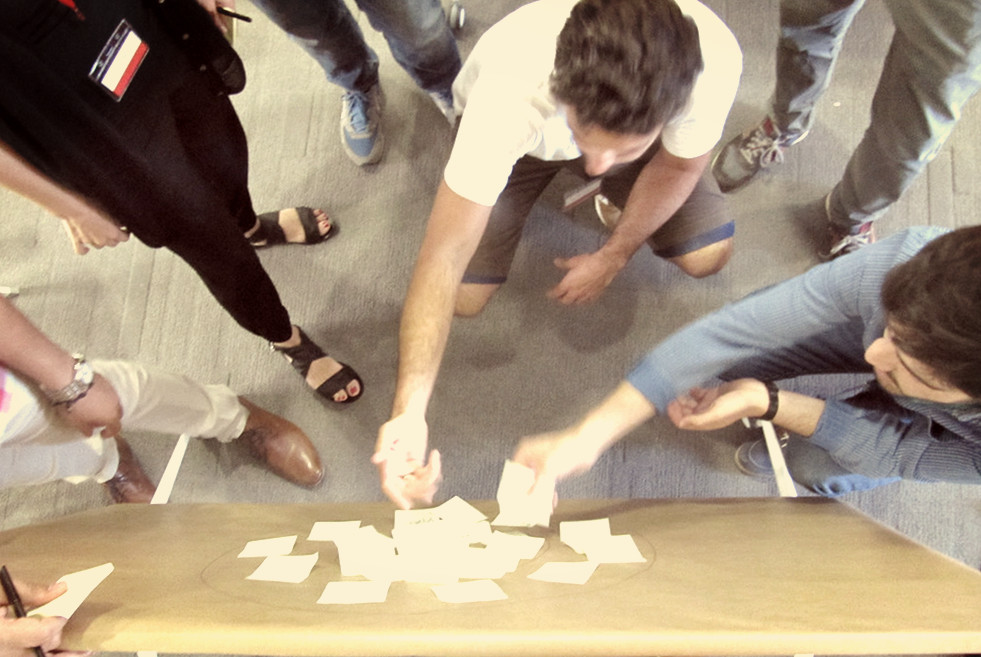
Each participant had to add sticky notes with the stakeholders that came to his mind, without discussing it with the others. In this step the amount should prevail over quality, regardless of whether two sticky notes had almost the same content. It took approximately 10 minutes.
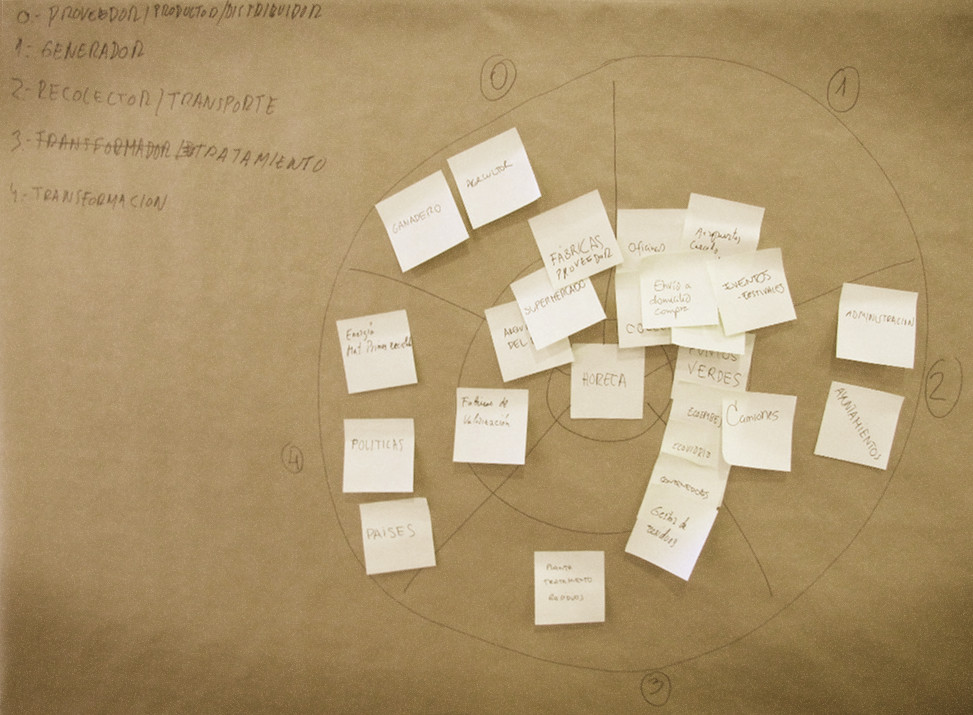
Context
This is the moment in which experts on the client's side help to understand the context of the problem to be solved. Three presentations were made by Ecoembes, in which we were told about the operation of waste separation plants, and previous research activities in Spain and other countries on improvements in the process of collection, separation of waste and recycling (payment by generation, incentive to recycling, tracking bags through RFID, smartag, NFC, etc.).
Stakeholders map review
After knowing the context, the stakeholder map was reviewed, adding those that were missing. Then they were grouped by type -producer, generator, collector, processor, transformator-, arranging them radially, dividing the circles like a cheese.
### How Might We
This is a very important activity on the first day of the SPRINT. We are going to start exploring ideas openly. Each participant must formulate, in sticky notes, questions starting with "How Might We...?". That is, how could we improve this or that, motivate the users to do this or that thing, and so on. Again, without interfering each other, and giving more importance on quantity over quality.
They are then arranged on a large paper and are sorted and grouped vertically by affinity.
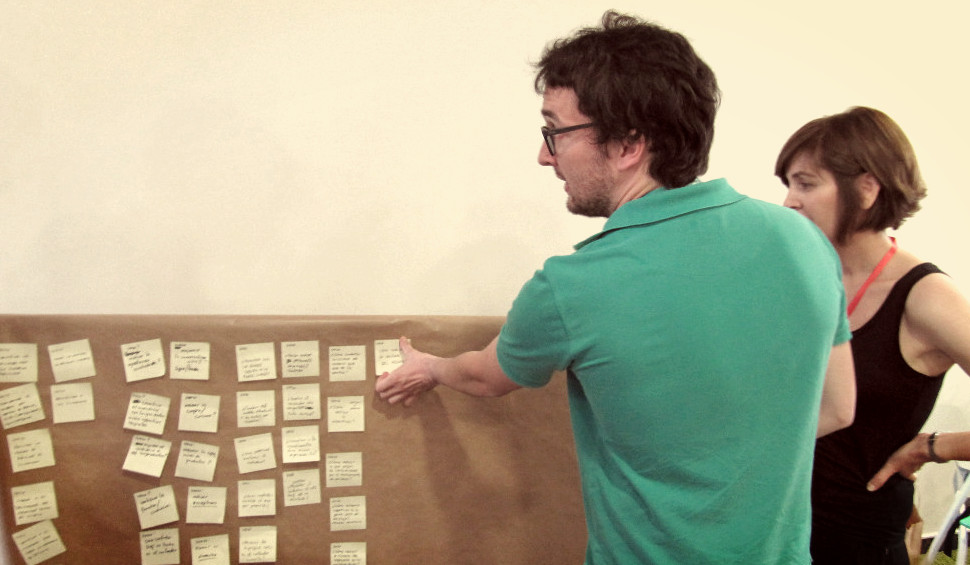
Afterwards, categories are created and similar sticky notes are placed underneath categories, putting one on top of another the ones that match exactly. Once grouped, we have an idea of the most repeated questions and the topics that we have given more importance to.
Then each person has 3 votes in the form of stickers. The votes must be placed on the board at the same time, in order not to influence others.
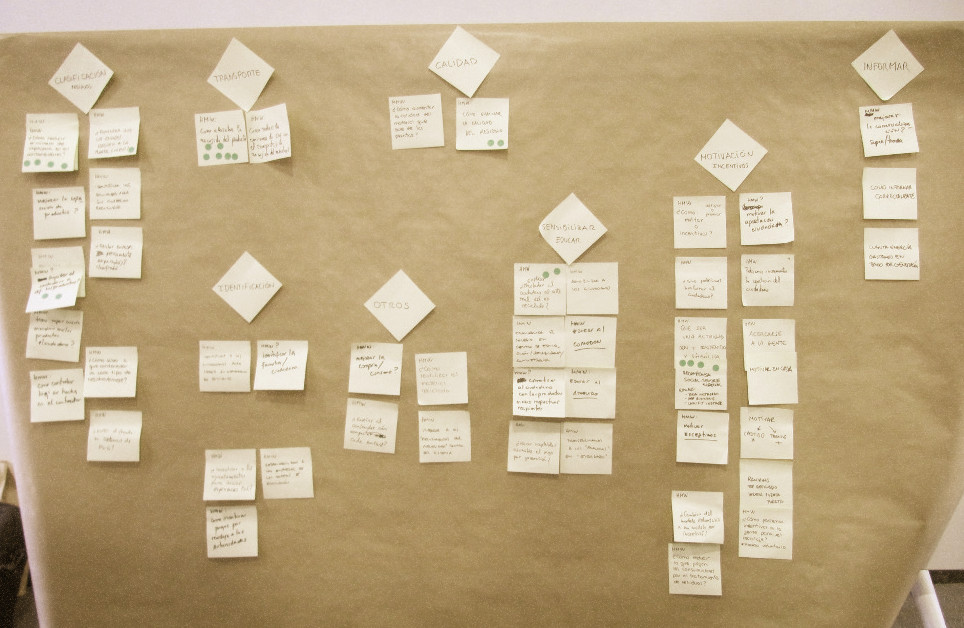
The sticky notes that have obtained votes are passed to the stakeholder map, placing them in the corresponding quadrant, according to the categories created.
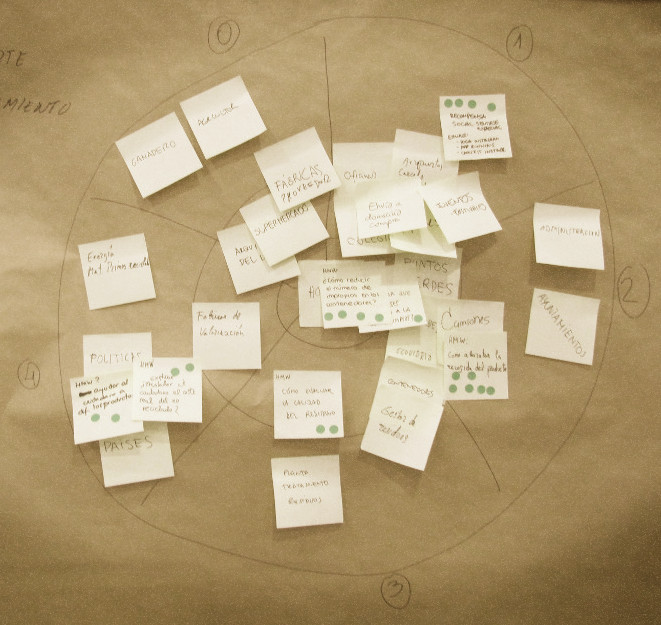
After ordering the stakeholders, it was decided on what type of user and stakeholders we were going to work with. In my group, we selected the HORECA channel (HOtels, REstaurants and CAtering), and the so called waste GENERATORS quadrant.
User interviews
A user interview script was prepared. These interviews should allow us to validate our first hypotheses.
These hypotheses included the type of average user that we intended to serve, which we decided would be restaurants with between 2 and 6 employees who had problems to recycle containers, due to lack of motivation, time or space.
The objective is not to direct the interview, nor to try to sell them a solution, but to find out their motivations and frustrations related to the recycling of domestic packaging. Finally we can ask some questions about the solution we have in mind.
The interview should not take more than 10 minutes.
In the afternoon we conduct the interviews, on the street or by Skype/telephone.
Each participant made 1-2 interviews, the objective being a total of 6 or more, a number that is considered representative. Among these 6 there will usually be 3-4 average users, 1 end up sample user (large restaurants) and 1 end down sample user (bars with only one employee).
Día 2. Divergir
Generate persona
The first exercise was to collect and synthesize the information from the previous day's interviews. The tool used was an Excel sheet, where all the responses of each of the users were collected, classified and then patterns were detected. Finally the frustrations of the user, their motivations and the verbatim (literal phrases full of emotions, anger, anger, etc., ideas with power) were identified.
This information was passed to a synthesis matrix, ordering the most repeated phrases and patterns in:
- Behavior patterns.
- Motivations (Gains).
- Frustrations (Pains).
- Verbatims.
After detecting the most repeated patterns, the person was generated, with following structure:
- Name and basic demographic data.
- History.
- Needs.
- Reasons/origins for that needs.
The model should look like this sentence (our persona was named Mario Kempes after the nickname of a bar owner from my quarter):
Mario Kempes is a 35-year-old chef who works in a bar that has 3 employees. He recycles oil and glass because they get paid for it and someone comes to pick it up, but he does not recycle plastics or cardboard for lack of economic incentives and space inside the bar. He needs to be paid, to be fined or getting the space issue solved in order to recycle more.
After analyzing the interviews, we verified that our initial assumptions were not validated, and our initial idea -a kind of label for responsible restaurants regarding the disposal and recycling of waste, which would serve to reward those who recycle the most- did not convince the owners of restaurants, so that we should pivot towards new solutions.
Lightning demos
Searching for projects, prototypes, products or services already developed, whose general idea is similar to the one chosen by the team, as a source of inspiration.
Brainstorming
During the stipulated time (about 10 minutes), each team member individually generated all the ideas that came to his mind, in sticky notes and under the following premises:
- Quantity should prevail over quality.
- Visuals should prevail over text.
- Each idea should be expressed in approximately 6 words.
- Ambitious ideas.
- Do not judge.
- You can build on other's ideas.
Once generated, each one reads aloud his sticky notes to the rest, and doubts are clarified.
They are then arranged on the board and ordered.
- They are put one on another when they say exactly the same.
- They are grouped by theme.
- Above each group of related sticky notes, a diagonal sticky note is used as a title.
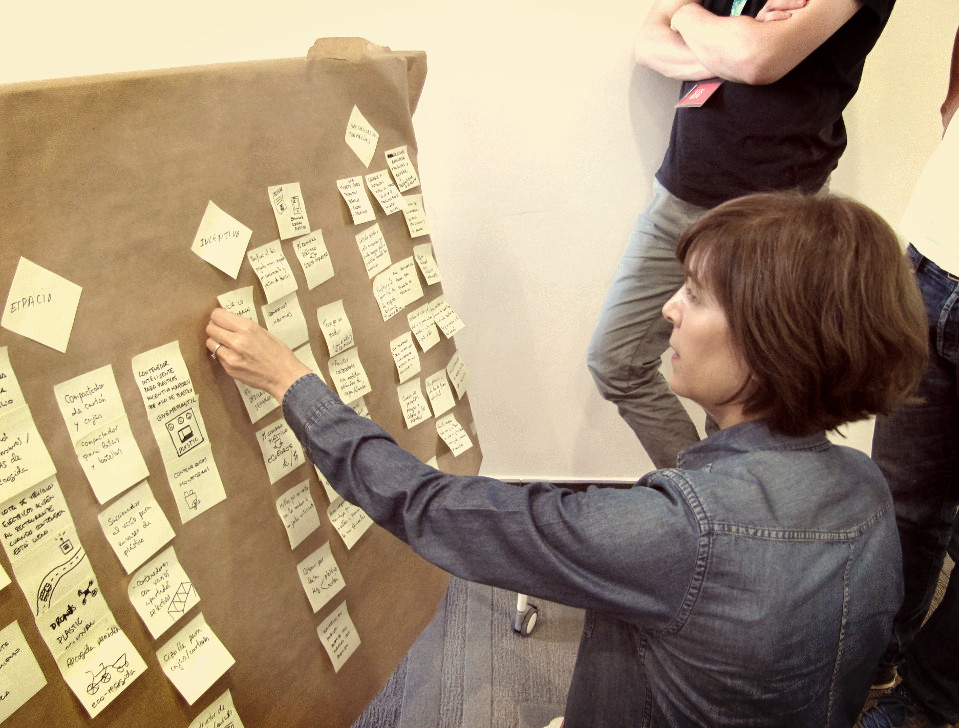
It's time to vote! Each member of the team takes 3 stickers to vote for 3 different ideas. The ideas that don't receive any votes are discarded.
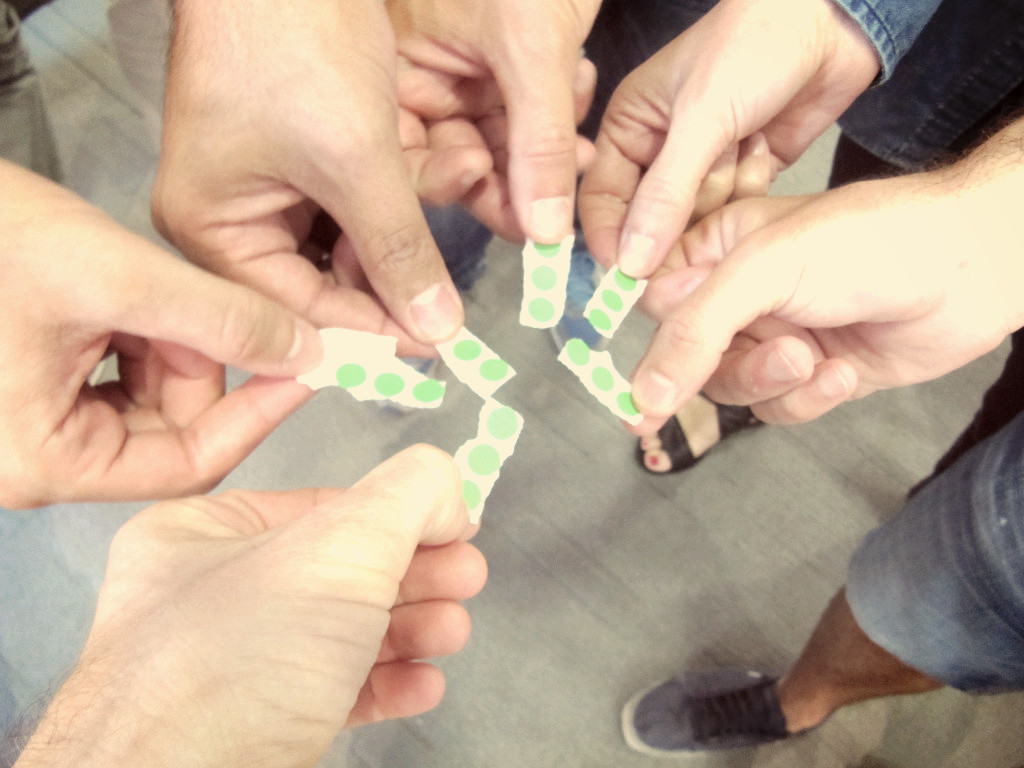
Among the ideas that received votes, a few are selected with which we will work, and the rest are discarded. It is not necessary to discard the least voted, although in principle it is logical, but the group can decide to incorporate some idea that has received few votes but that makes sense along with the rest. These ideas are arranged on the board, where we can see the big picture of our future solution.
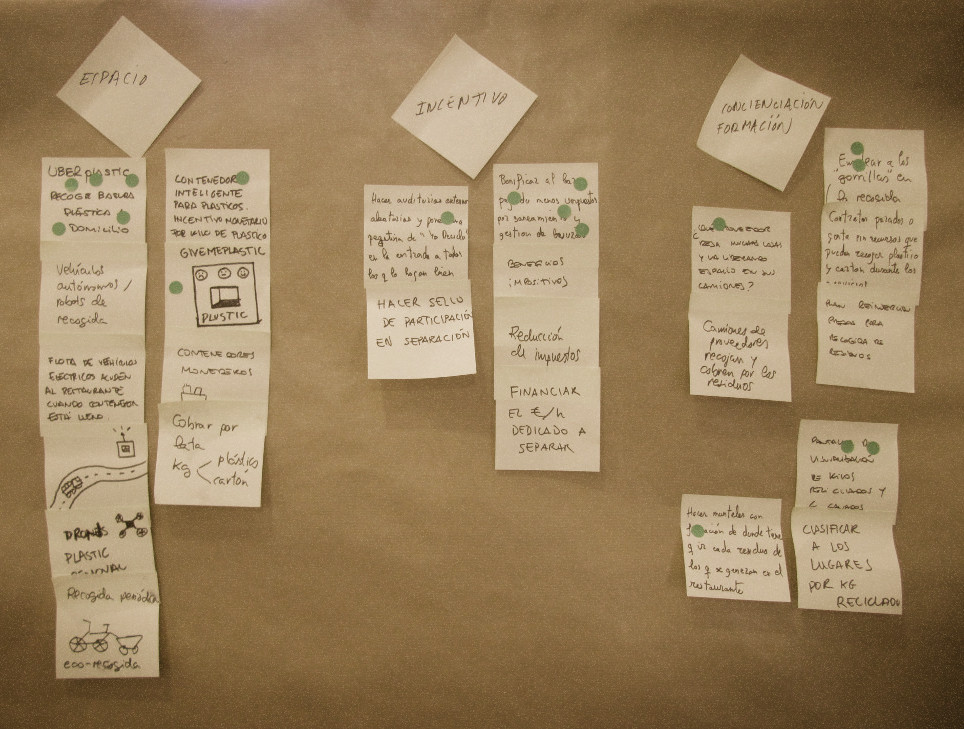
Crazy 8
Each member of the team had to take a folio and fold it in 8 quadrants. In each of these quadrants we have to draw a step of the outline of the solution to developed. In this exercise, every minute we write or draw a quadrant. At the end of the 8 minutes you should have a sketch of the prototype.
This was my crazy 8 for the idea that we decided in the previous step.
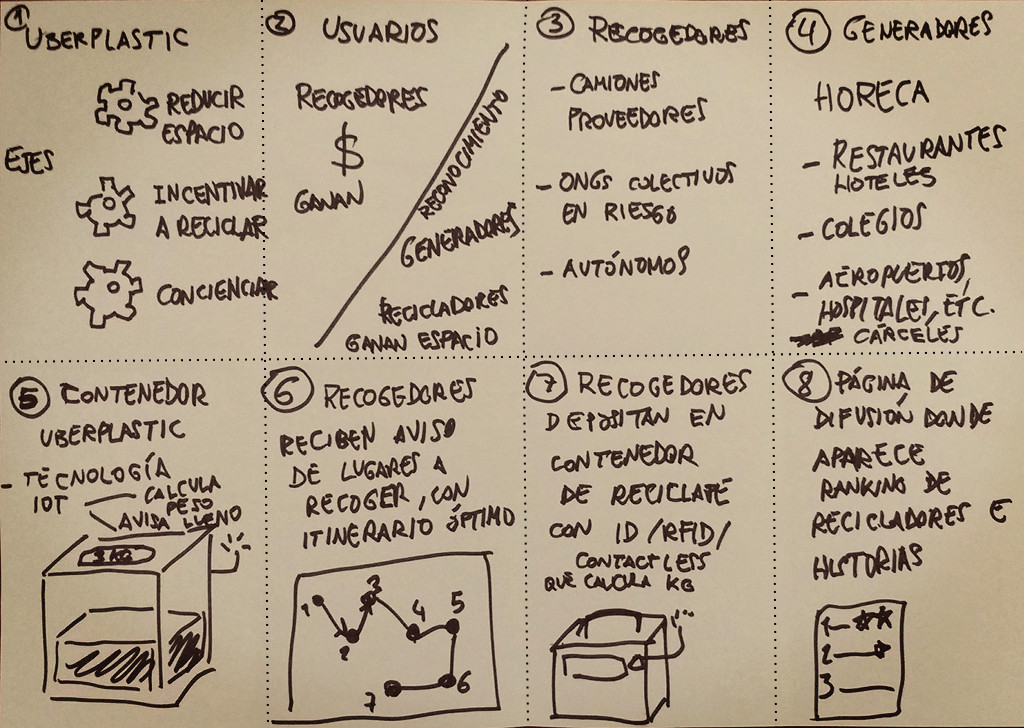
Individual prototype
Each member of the team, for approximately 1 hour, had to make a prototype of the solution to be developed. It should be done on paper, using one or several sheets, with text, diagrams, drawings and sticky notes.
When the time was over, the prototype was handed over to the facilitator, who the next day arranged it in the form of an Art Museum on the board, for its exhibition.
## Day 3. Decide
Art Museum
In each group board, the individual prototypes were exhibited. The members of the group read to themselves each proposal, without knowing who had made it.
One by one, it was revealed who designed each proposal and everyone could ask questions to clarify doubts.
Next, each member of the team had to take 5 stickers to vote on the aspects of each prototype that they liked the most. The procedure to follow is thinking first and then voting at the same time to avoid influencing others.
Subsequently, each member of the team took a larger blue sticker and cast a vote on their preferred idea. You also should think first and vote later, all at once.
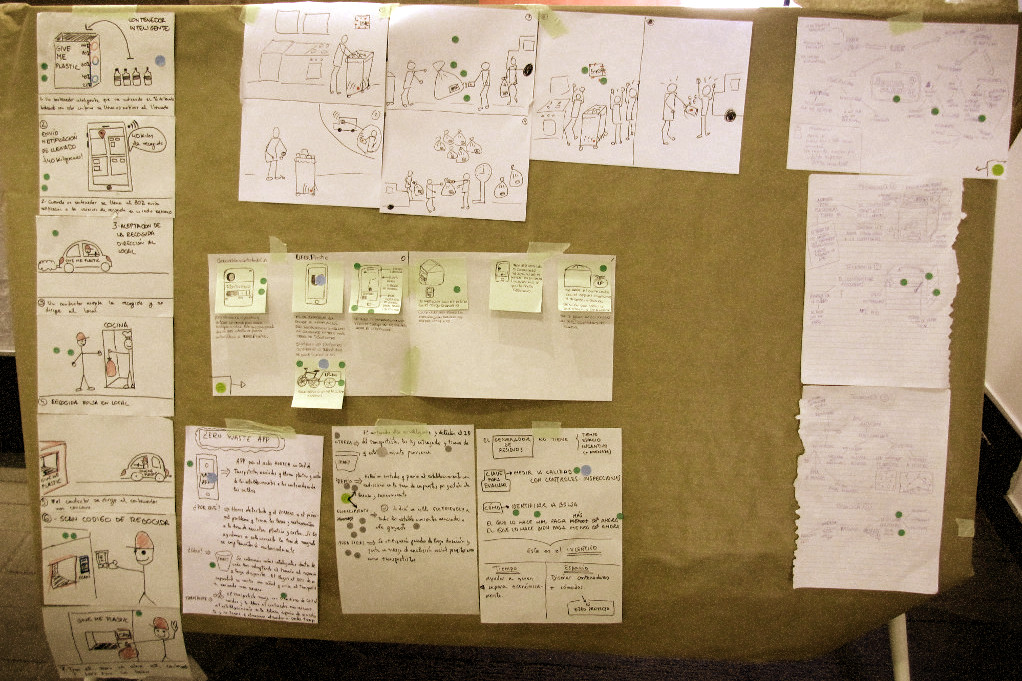
Individual pitch
Each member of the team had to present their idea to the client in a minute and a half.
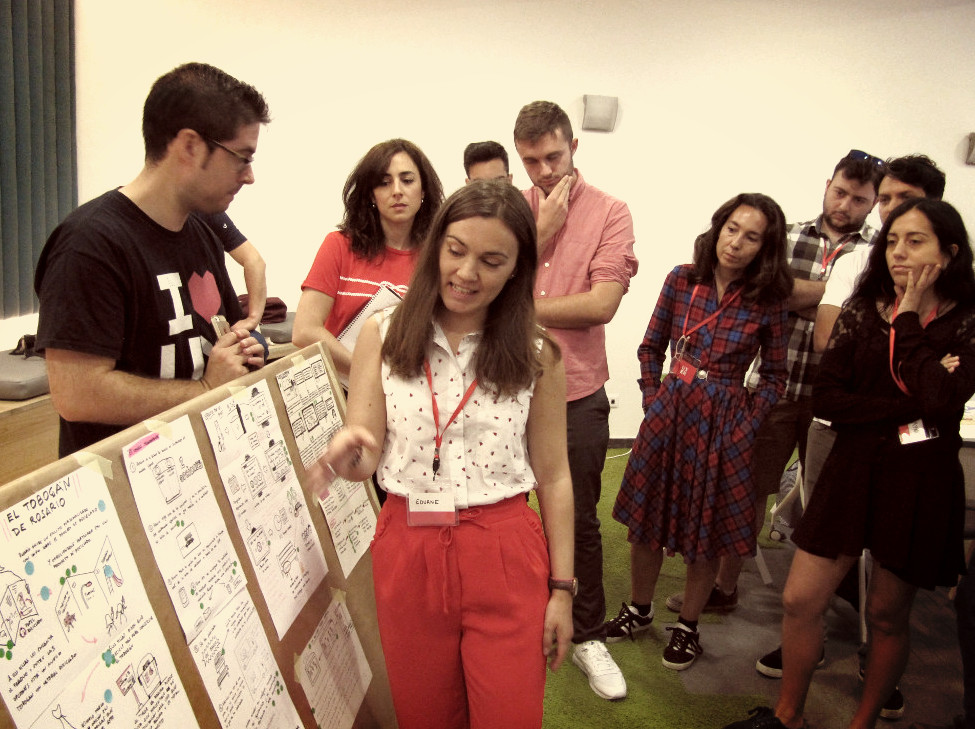
Once all the proposals were presented and after a time of reflection, the client (called decisor in the Design SPRINT methodology) indicated which aspects he valued positively of each proposal and signaled with yellow stickers what were the 2 or 3 ideas that he wanted to include in the final prototype.
User journey
Individually, and taking as input the most voted points of the prototypes and the customer feedback, each member had to generate a user journey in 8 steps. Using 8 sticky notes, in each one we write a phrase summarizing a step of the user journey of our product or service. Conceptually, we distribute them in 3 phases:
- Before: steps that are taken before using the product or service
- During: steps that occur during use
- After: steps that occur after use
Once the individual user journeys are worked out, on the board, we distribute in 8 columns the user journeys of all the members of the team. Initially each user journey will use the 8 columns, along a row.
Then we order them, grouping similar steps or steps that identify the same action, and placing them under the one that best summarizes it. We must have a user journey with 8 steps, and in each column we will only have a few sticky notes (one or two) for the different ideas that have arisen for this step.
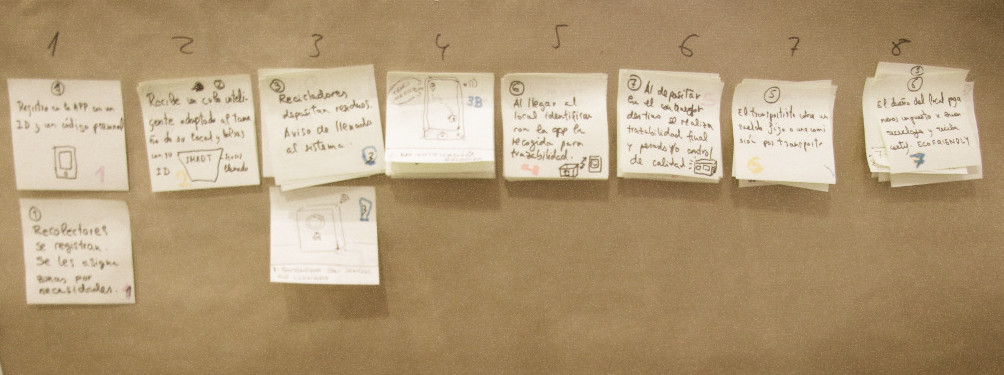
User journey pitch
A member designated by the team had to make a new one and a half minute pitch describing the user journey.
### Prototype draft
Team members had to work on creating a new draft of the prototype, incorporating the received feedback and the generated user journey. At this point you can distribute the work among team members.
Day 4. Prototype
Role designation
The team had to designate several roles for the realization of the prototype, where a person could assume several roles:
- Designers: graphic design of product, presentation, landing page or application mockups.
- Creators of content: images and texts for presentation, landing pages or application mockups.
- Copys: texts for calls to action and other creative texts.
- Stitcher: the one that is in charge of assembling the pieces, and makes sure that what others produce makes sense together.
Prototyping
The members of the team had to work on the creation of the prototype, individually, in subgroups or as deemed appropriate. Finally the stitcher had to be in charge of the coordination and union of the pieces.
Said prototype is only a facade of the product or service to be designed, in no case is it intended to implement a product exhaustively, since time is extremely limited. The objective of this prototype is to be able to validate our assumptions through the tests that will be carried out the next day.
In the case of my team, the prototype had to portray a plastic collection service in the restaurants. This service included the use of a mobile app, but this app was not the central part of the application, so we decided to make a commercial presentation instead of a navigable prototype.
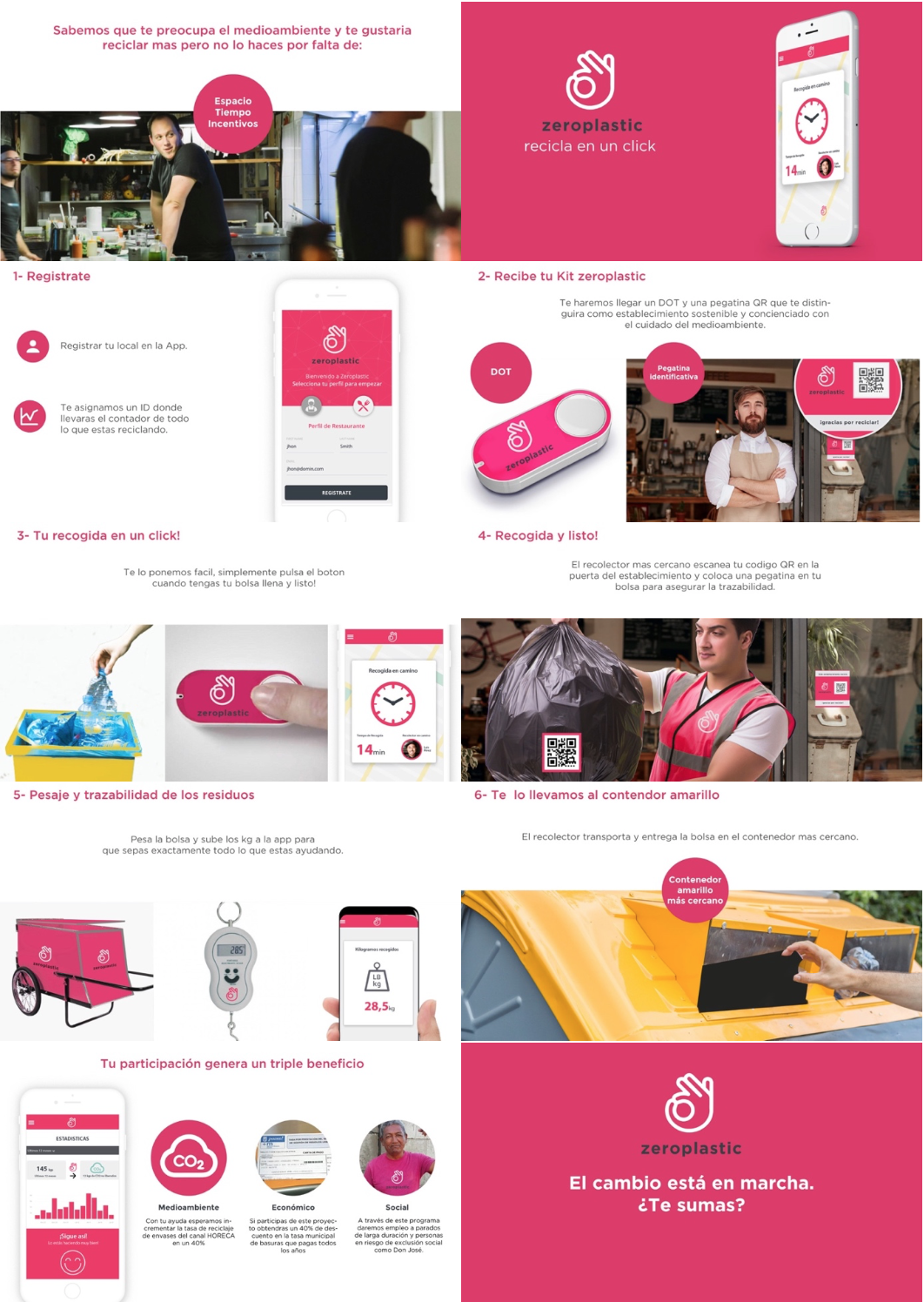
Other teams estimated making physical prototypes by means of boxes, paper, etc., since they had to simulate electronic devices that do not exist.
## Day 5. Test
Validation interview script
In the first place, it was necessary to write a script for an interview for the final user, including how he will be addressed, in case of cold-door interviews.
Once again, the interviews should seek validation of the product, not its acceptance by the user.
- Does our solution meet your needs?
- Are you able to use our interface / service?
- What do you like or do not like about what we have done?
- What would you like to improve?
Consequently, this the methodology will look for:
- Use open questions instead of directed questions.
- If there is a usable or clickable prototype, let the user interact with it, find out if he understands it, and find his blockages or frustrations regarding the interaction.
- Provide the minimum context explanation before facing the user to the prototype, instead of telling everything, to see if he understands it, and avoid conditioning him.
In our case, there was no clickable prototype, as it was more of a service than the application itself, so we chose to show the full presentation and find out later what he thought of the solution.
Validation interviews
In order to conduct interviews, depending on whether they are cold-weather or previously arranged, you will have to go outside or use an interview room, or Skype.
The ideal case would be to arrange a series of face-to-face interviews with end users, and to have a room in which only one person speaks with the user, without taking notes, in order to maintain visual contact. From the outside, other people would observe the interview, including the screen that the user is handling if that is the case, and they would take notes of everything relevant of what the user says and what he actually does. Ideally, everything would be recorded on video to be available for later review.
Alternatives to this ideal situation include conducting the interview by Skype and recording it, or conducting the interview in person, 2 or more people, of which one will speak with the user without losing visual contact, while others will record in audio/video (if the person can be self-conscious, audio may be better, since the recording is not perceived) and write down comments.
The number of validation interviews is about 10, among which we must target our target user (persona) at least 80%.
Validation conclusions. Lessons learned
The team meets again and patterns are extracted from the interviews. For this we will classify the interviewed users according to their profile and we will group the received answers.
From this learning we will draw conclusions about which parts of the solution can work and which do not, as well as the solution on a global level.
- Does our proposal make sense for users?
- Do you know how to interact with her?
- Can we improve it? How?
- Should we keep with this approach or discard it?
Final pitch
The team had to prepare a final pitch to present to the client the prototype, along with the lessons learned from the validation. This final pitch should last 5 minutes.
The pitch was made to the client, who in turn provided feedback to the teams.
Conclusions
The final impression was that, in a very short space of time a high quality result was achieved, where a lot of creativity and original solutions were put into play. At several points, it was necessary to change of direction, when the initial assumptions were not validated, and it was possible to do that without too much resistance coming from the authors of these initial ideas. Apparently, the ideas did not have a single author and, in some way, all the members of the team felt involved and made their contribution, both in the generation of ideas and in decision-making.
It is a rather surprising process from the inside, since at the beginning we come up with a lot of disparate ideas, that are gradually sorted out and discarded, under a lot of time pressure, until finally everything starts to converge in a way that seems natural.
Also, due to the philosophy of exploration without censorship, the solutions start being very ambitious and not feasible, but as the process progresses some ideas are canceled, recombined with others or degraded solutions are found for the more science-fiction ideas, so that the final solution is feasible. This allows us to get to put into practice ideas that initially we would have discarded because they seemed impossible.